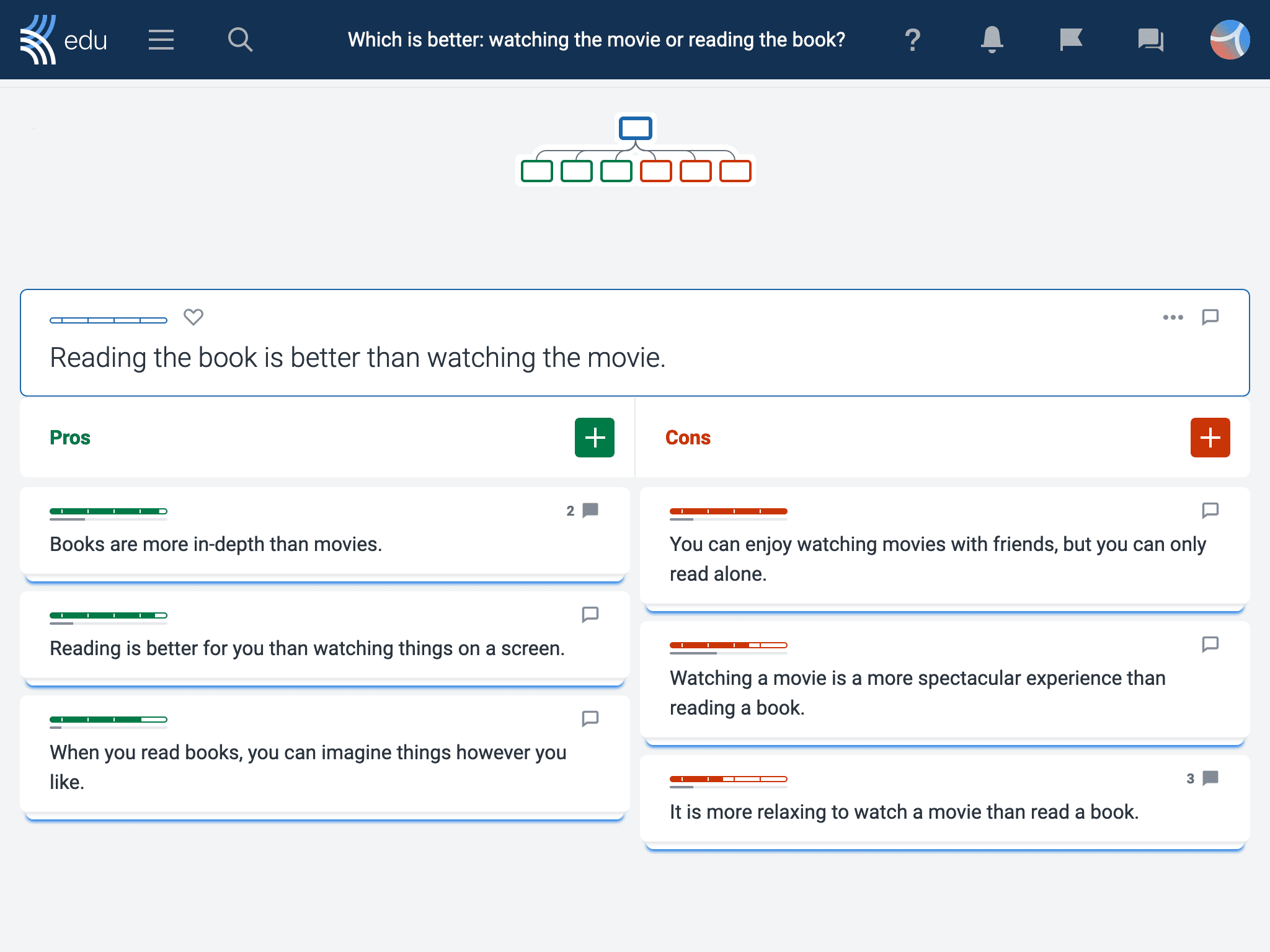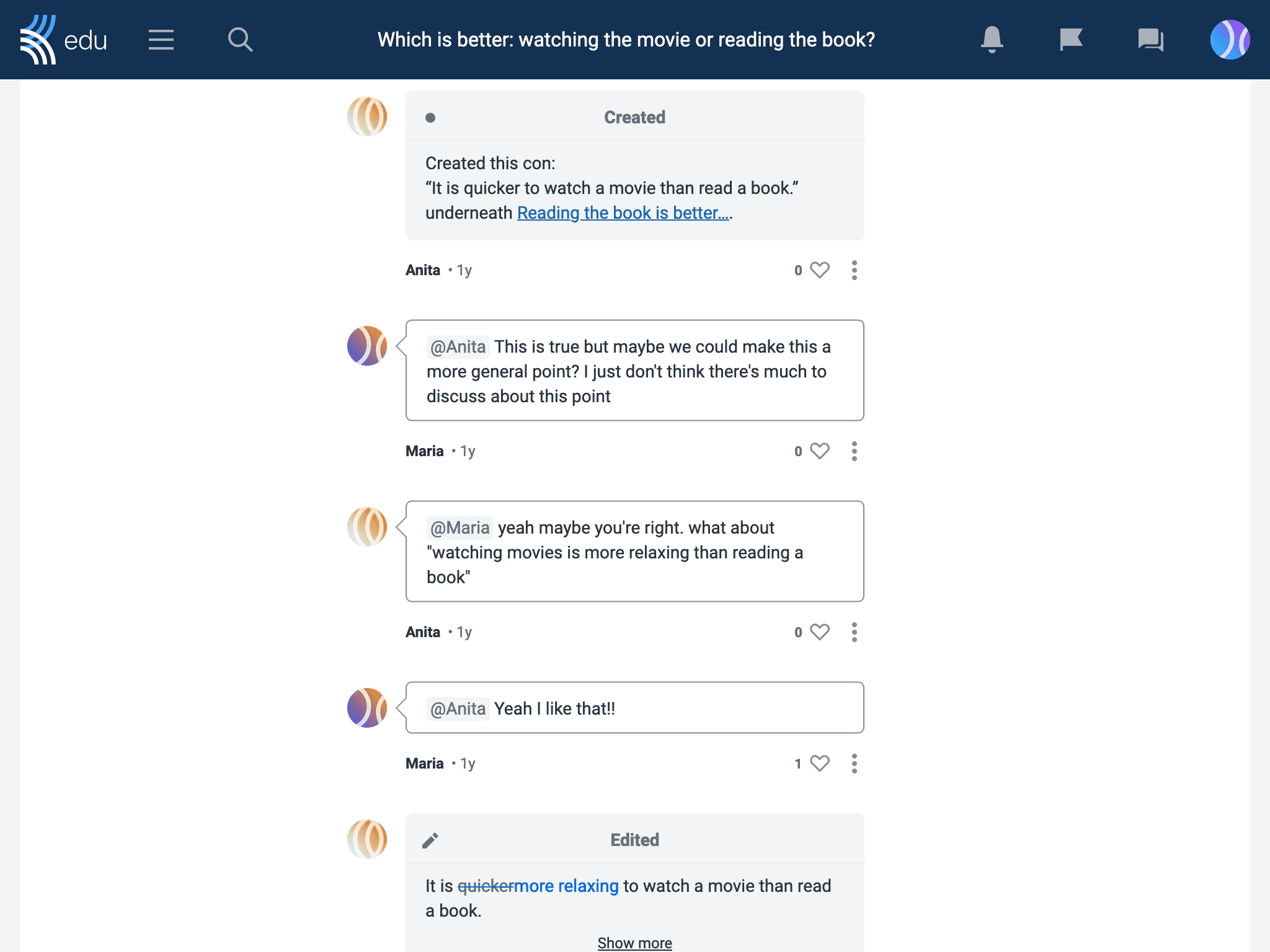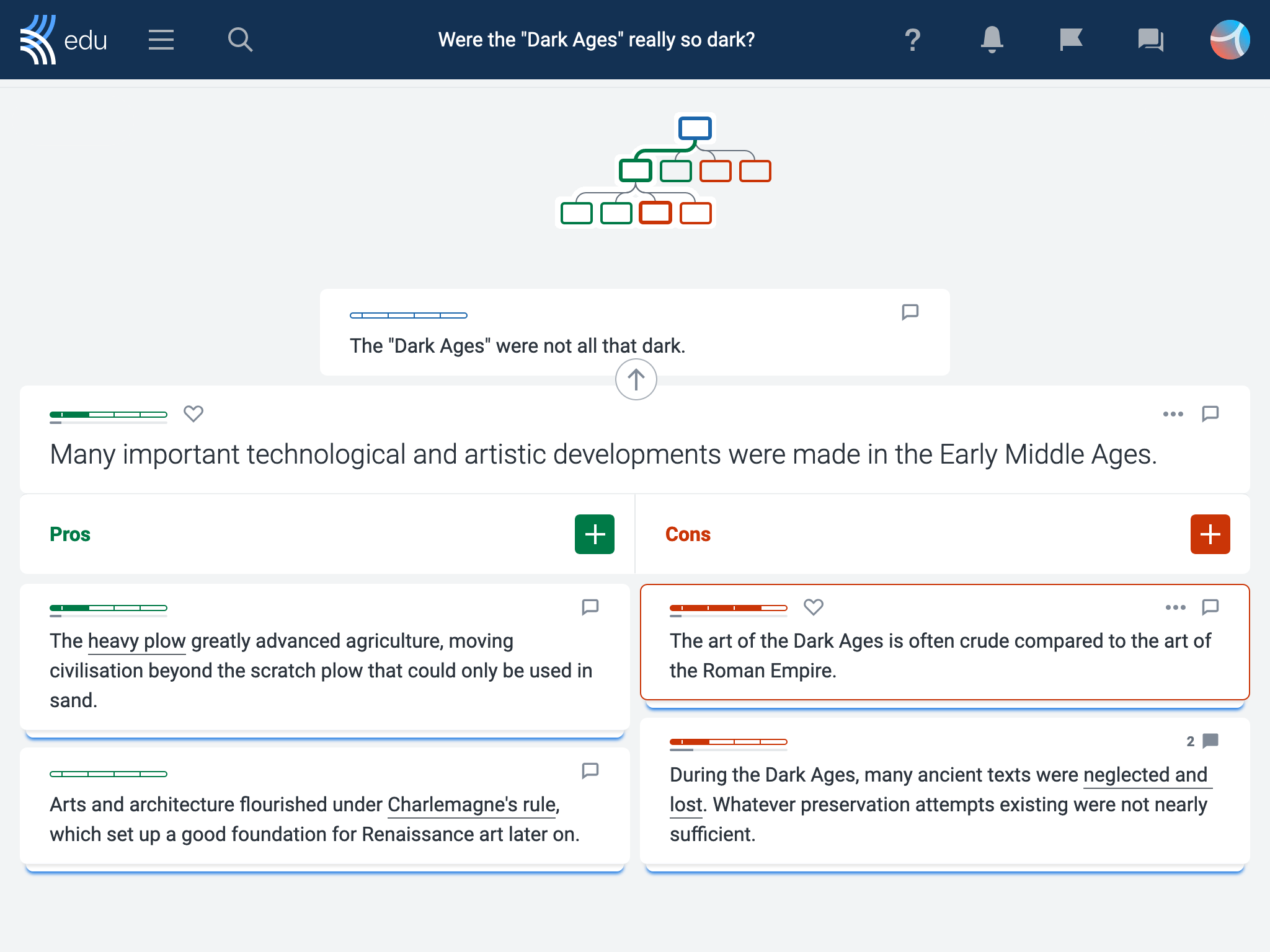There are lots of things to keep in mind while trying to hold a successful class discussion. Kialo Edu is designed to manage these things so you can get the most of of class discussions with students!
That said, we have a few tips that we’d love to pass on. Take a look at how you can use Kialo Edu to maximize the success of your class discussions!
1. Formulate good top-level claims
Kialo Edu builds out lines of argumentation in a branching, tree-like structure. Just like a real tree, a Kialo Edu discussion needs a stable core trunk to hold its branches. In this case, what matters most for the stability of the debate are the very top-level claims located just below the thesis.
You can create the top-level claims yourself to get your students started. You can also have your students brainstorm the most important ideas to debate right at the start. Give your students a few minutes to add all the ideas they have, then have them vote on the claims. Whichever claims they rate as the most impactful for each side are the top-level claims your class can focus on!
We recommend creating just a few well-formulated top-level claims. By limiting the amount of top-level claims, students are encouraged to develop and expand logical lines of argumentation.

2. Logically order claims in the discussion
Kialo Edu aims to help students develop logical lines of argumentation. Ideally, each claim should have a clear logical link to the claim above it, so that groups of claims considered together form a cohesive argument for or against the thesis.
Additionally, claims that are toward the top of the discussion should be more general. This better scaffolds information, as it directs student focus on the most important ideas for the debate, and avoids overloading them with content.

As the lines of argumentation develop, the claims on each level of the discussion should become more specific. This way, your students can group related pros and cons together into one broader argument for or against the thesis.
You can also guide students on where to put claims in a discussion through comments. All claims in Kialo Edu discussions can be easily moved around, or even linked in more than one location. So, even if a student creates a claim in one location, that doesn’t mean it has to stay there!
3. Encourage students to interact with peers’ claims, not just their own

The most successful discussions on Kialo Edu are those that students develop collaboratively. Some students might prefer to only support and refute their own claims. However, this defeats the purpose of discussion — you want your students to discuss the topic with each other!
To begin, consider selecting a topic that students can engage with confidently, but that will also spark contrasting opinions, such as whether it’s ever okay to lie, whether it’s good to have siblings, or even whether students should grade their teachers!

Encourage students to add pro and con claims beneath their classmates’ claims as much as possible. Our Tasks feature is specifically designed to help with this. You can set goals for your students to hit, including tasking them to create claims that respond to others’ claims.
4. Keep the discussion focused with subsequent, high-quality claims

One of Kialo Edu’s greatest strengths is how it helps you to break down complex arguments into their elements and logically map them out. Here’s how to write claims that will build the best possible argument map.
A good claim makes a single, focused point. This makes it easier for students to evaluate a claim, as the arguments are broken down into their most elemental form.
Imagine, for example, a discussion about whether the Early Middle Ages can truly be considered the “Dark Ages.” If a student wants to make the argument that the Early Middle Ages had several advancements in technology and culture, it is best to do so with a simple claim.

In this case, the student could start with a claim arguing that there were indeed advancements during this time period. Any logically-related points can then become their own focused sub-claims. One sub-claim might focus on developments in agriculture, another on art. This creates space for debate over each of these distinct fields.
If students wanted to have a more extensive debate comparing the art of the Roman Empire and the art of the Early Middle Ages, they might create a new, broad, pro to the first con claim in this example. They could then put further pros and cons that discuss art under that claim, along with other claims comparing European art during the two time periods.
5. Use appropriate qualifiers in claims to avoid overstatements and sweeping generalizations
Students often mistake strongly-worded arguments for strong arguments. While the two sometimes overlap, it’s often necessary to use qualifiers (e.g., may, might, sometimes, often, etc.) to write factual arguments that aren’t easily deflated by a single counterexample.
With its highly visual and to-the-point structure, Kialo Edu makes it easy for students to point out overreaching and weak arguments. In turn, students are able to easily edit and improve their claims to make stronger arguments as their peers challenge them.
6. Use factual evidence and cite sources in claims
Another key to writing a successful claim is to support or refute any opinions with facts. Using facts keeps the discussion grounded in logic. Otherwise, the discussion can turn into a potentially endless stream of unsupported assertions!
Direct students to make use of the Insert link/source button when writing claims. You can even set a Task for all your students to add a minimum number of sources.
Students can also add a specific quote or note to highlight the most relevant information from the source. And for easy reference, Kialo Edu automatically puts together a list of all linked sources in a discussion!

5. Represent opposing viewpoints in good faith
While Kialo Edu is an argument-mapping platform, it’s not just a place for arguing. Rather, Kialo Edu is a tool for representing lines of reasoning around a given question, wherever they may lead. This way, students can comprehensively map out and examine multiple perspectives on an issue.
Thus, you can encourage students to not only add their own perspectives to a discussion, but to articulate the opposition’s point of view as well. However, this only works if students are representing opposing viewpoints in good faith. If students misrepresent viewpoints, the discussion can fall into logically fallacious straw-manning.
Whether you’re new to the platform or a frequent user, we hope that these tips will help you and your students have a successful class discussion on Kialo Edu.
If you have any more questions or ideas about the best ways to use Kialo Edu, send as a message at feedback@kialo-edu.com, or connect with us on social media! We look forward to helping you have engaging, successful class discussions with your students.

